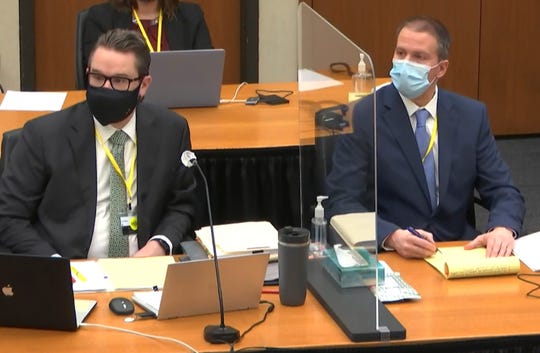‘We have a duty of care’: Prosecutors say Derek Chauvin, other officers betrayed policy by not giving aid to George Floyd
MINNEAPOLIS — The prosecution of Derek Chauvin in George Floyd’s death has focused not only on its arguments that the former police officer is culpable, but a more elementary issue: That he failed to carry out his duty to provide basic care when Floyd was in medical distress and then became unresponsive.
Several Minneapolis police department officials testified Chauvin violated department policy by failing to move Floyd on his side to ease his breathing once he had been restrained face-down on the ground.
Prosecutors have presented video showing Chauvin continuing to press his knee on Floyd’s neck even after Floyd was face-down, with his hands cuffed behind his back.
After another officer told Chauvin that Floyd had no pulse, Chauvin and his fellow officers continued to hold the position for 2 1/2 minutes instead of attempting CPR or chest compressions to revive him.
“When someone is in our custody, we have an obligation to provide for their care,” Minneapolis Police Chief Medaria Arradondo told jurors Monday.
That’s true even if an officer is applying defense tactics, the chief said. “They’re still in our custody,” he said. “They have rights.”
Chauvin has been charged with third- and second-degree murder and second-degree manslaughter in Floyd’s death.
The defense has argued officers were distracted from their care of Floyd by an angry crowd.
The department’s duty of care policy has been a key element of the case against Chauvin. Prosecutor Jerry Blackwell raised the issue in his opening statement last week, repeatedly telling jurors that a core principle of policing is that someone “in your custody is in your care.”
‘No justice, no streets’: Still grieving, Minneapolis residents wonder how city will move forward after Derek Chauvin trial
“It’s not a feeling – it’s a verb,” Blackwell said. “It’s something you’re supposed to do, to provide care for that person.”
Instead, Blackwell said, Chauvin engaged in an “eminently dangerous activity” without regard to the impact on Floyd’s life.
The defense has argued Chauvin and the other officers were unable to care for Floyd because they were distracted and threatened by a crowd of vocal, upset bystanders.
“As the crowd grew in size, seemingly so too did their anger,” lead defense attorney, Eric Nelson, told jurors. Videos from bystanders and police body cameras played for the jury show roughly a dozen people standing on the sidewalk once Floyd is under Chauvin’s knee.
“Remember, there’s more to the scene than just what the officers see in front,” Nelson said. “There are the people behind, people across the street. There are cars stopping, people yelling. There is a growing crowd that officers perceive to be a threat.”
Sarah Davis, executive director of The Legal Rights Center in Minneapolis, a legal aid nonprofit, said she was shocked “that anyone would consider what Chauvin and the other officers did to Mr. Floyd as constituting ‘care.'” She said it reflected “a narrative built on racist ideas.”
‘You can’t paint me as angry’
This perception of a threat is a core thrust of Nelson’s argument that any objectively reasonable officer, facing the same circumstances, would have responded similarly.
It is also the argument he must make, as a defense attorney, per the Fourth Amendment and U.S. Supreme Court case Graham v. Connor, which sets the “objectively reasonable” standard for judging the legality of an officer’s use of force. It has been adopted by law enforcement agencies across the country, is taught in training, to recruits, and repeated at daily roll calls.
Nelson said the screaming crowd hurled expletives at the officers, which caused “these officers to divert their attention from the care of Mr. Floyd. At this location, questions emerge about the reasonableness of the use of force. And this will ultimately become one of the decisions that you have to make.”
In this image from video, defense attorney Eric Nelson, left, and defendant former Minneapolis police Officer Derek Chauvin, right, listen as Hennepin County Judge Peter Cahill discusses motions before the court Monday, April 5, 2021, in the trial of Chauvin at the Hennepin County Courthouse in Minneapolis. (Photo: AP)
That’s why, as the jury has heard from more than 20 witnesses thus far, Nelson has been asking bystanders whether they were “angry” or “upset” that day. Many bystanders testified in court that they were not threatening to the officers but were, rather, too frightened of the officers to intervene. One, mixed martial arts fighter Donald Williams, whom the defense has focused on as alleged key threat to the officers, told Nelson during a tense exchange: “You can’t paint me as angry.”
Nelson has also asked Minneapolis police officers called to the stand how they would handle hypothetical situations involving both an ongoing threat and a medical emergency. He’s twice raised the scenario of a gun fight, asking officers whether they would first administer medical aid to someone in need or engage the shooter.
Derek Chauvin trial live: Expert says Chauvin used ‘deadly’ force on George Floyd; brother says trial is ‘agonizing’
Nelson has appeared to argue that the officers were required to continue to use force because of the distracting menace of the crowd, which appeared to be experiencing its own “crisis” from watching the police encounter with Floyd.
But Arradondo, the police chief, said the use of force “absolutely” violated the department’s policy and the officers also failed to provide the care to Floyd required by policy while awaiting emergency medical services.
Police are trained first responders and taught first aid, including CPR, chest compressions and how to deal with bleeding. Officers also attend an annual refresher course on the department’s use-of-force protocol.
“If it’s a critical situation, you have to do both” –– call for an ambulance and provide first aid like CPR, which involves chest compressions to return blood flow to the body and heart, said Minneapolis police Officer Nicole Mackenzie, who is an EMT and conducts first aid education for officers. She is also an emergency medical response instructor.
Lt. Richard Zimmerman, the department’s most veteran officer, also told jurors last week that officers need to provide medical assistance “before” an ambulance arrives. “There is absolutely an obligation to provide medical intervention as soon as necessary,” he said.
A use-of-force expert witness called by the state, Los Angeles police Sgt. Jody Stiger, testified Wednesday that officers were obligated to act when Floyd was in medical distress.
“As the time went on, clearly in the video you can see that Mr. Floyd’s health was deteriorating, his breath was getting lower, tone of voice getting lower, his movements were starting to cease,” Stiger said. “At that point as an officer on the scene, you have a responsibility to realize something is not right, something has change drastically from what happened earlier, and you have to take some sort of action.”
Why didn’t officers perform CPR?
Sgt. Ker Yang, a crisis intervention director for the Minneapolis police, told jurors Tuesday that the department’s crisis intervention training is designed to enable officers to make decisions as they interact with people in crisis. The ultimate goal, he said, “is to see if that person needs help,” from medical personnel or other assistance.
“If someone is in need of medical attention, then we give him medical attention,” Yang said.
Last week, prosecutors asked paramedic Derek Smith, who responded to Floyd that day, whether officers provided any aid before their arrival or at the trained EMT’s direction.
Smith told the prosecution that an officer administered chest compressions at his direction. Officers, however, did not give any medical aid to Floyd on the scene at their own discretion, despite the crowd yelling nearly 30 times for officers to check Floyd’s pulse, according to video evidence.
Dig deeper on race and identity:Subscribe to This Is America, USA TODAY’s newsletter
Officer J. Alexander Keung eventually checked Floyd’s pulse at Officer Thomas Lane’s behest, according to the court record. It was Lane’s fourth day on the job.
Keung checked and said, “I can’t find one,” according to the court record.
Chauvin responded, “Huh?”
Keung clarified that he couldn’t find Floyd’s pulse.
That’s when Chauvin squeezed Floyd’s fingers and got no response.
Still, Chauvin continued to kneel on Floyd’s neck area for another 2 1/2 minutes while Floyd had no pulse. Only once the paramedics arrived and one gestured for Chauvin to move, so Floyd could be loaded onto a gurney, did Chauvin rise off of Floyd.
Mackenzie, the first aid trainer, said pressing fingers on a person is one way that is taught to determine if a person is responsive. If there is no response, the officer is taught to check their airway, breathing and circulation, including their pulse.
“If you don’t have a pulse on a person, you immediately start CPR” and chest compressions, Mackenzie said. The officer should not stop until relieved by someone with superior training, there are signs of death, among other factors. She said this is training offered annually to police officers.
Dr. Bradford Langenfeld, who directed the care of Floyd at Hennepin County Medical Center and spent about 30 minutes trying to resuscitate him before pronouncing him dead, told jurors there’s approximately a 10-15% decrease in survival rate for someone in cardiac arrest per every minute without CPR.
“Any time a patient spends in cardiac arrest without CPR markedly decreases the chances of a good outcome,” he said.
Davis said she was jarred by the juxtaposition of the term “care” as used by the defense, next to how the ER doctor, Langenfeld, called by the state, talked about the care provided to Floyd.
“You can see two totally different narratives playing out in the trial,” Davis said. “That’s not unusual, of course. Each side wants the jury to connect with their narrative. But I am surprised that the defense would choose to try to make this a significant part of their narrative, since it feels pretty disingenuous.”
Follow Tami Abdollah, USA TODAY national correspondent, who is covering the Derek Chauvin trial, on Twitter at @latams
Source: Read Full Article


